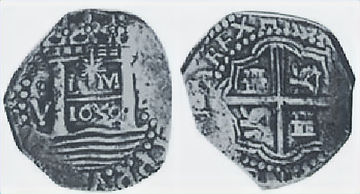Cobs Coinage 1572-1773
With Spain's conquest of the New World, vast reserves of silver and gold were discovered, leading to the establishment of mints in key colonies across the Americas. This marked the birth of cob coinage, which emerged during the reign of Philip II (1556–1598) to address the increasing demand for currency in Spain's growing empire.
Cobs were the result of a mass-production technique designed to quickly mint coins. Unlike modern, mechanically struck coins, cobs were crudely fashioned. Silver or gold bars (ingots) were cut into approximate shapes, hammered by hand, and stamped with dies. Their uneven surfaces often resulted in faintly engraved details, making each cob unique.
The term "cob" is thought to derive from the Spanish phrase "cabo de barra", meaning "end of the bar," referring to the ingots used in their creation. These coins are also known by the Spanish term macuquinas. In the Philippines, cobs are locally called hilis-kalamay, a name inspired by a local rice cake dessert that they resemble.
Cob Denominations and Weight Standards
Cobs were initially produced in denominations of 1, 2, 4, and 8 reales, with a ½ real introduced later under Philip IV (1621–1665). Despite their crude appearance, they were carefully weighed to meet specific standards. If a coin fell below the required weight, a portion was clipped off to adjust it, further distorting its already irregular shape.
Below are the standard weights for reales and escudos with 93% and 92% purity respectively:
8 reales = 27.47 grams | 8 escudos = 27.06 grams
4 reales = 13.73 grams | 4 escudos = 13.53 grams
2 reales = 6.87 grams | 2 escudos = 6.77 grams
1 real = 3.43 grams | 1 escudo = 3.34 grams
½ real = 1.72 grams | No escudo equivalent
Cob Designs: The Habsburg Shield and Cross, and the Pillars of Hercules
Cobs featured distinct designs that evolved over time. Beginning with Philip II, the "shield type" design was introduced.
Obverse: A crowned Habsburg shield, bearing the king's name and the Latin phrase "DEI GRATIA" ("By the Grace of God").
Reverse: The arms of Castile and León, divided by a prominent cross. Surrounding this design, the legend often read "REX HISPANIARUM ET INDIARUM" ("Of the Spains and the Indies"). Mexican-minted cobs are easily identifiable by their pointed fleur-de-lis motifs surrounding the cross.








Image Source: PCGS, Mexico, Colonial (Hammered) Real and Escudo Coins
By 1652, the Habsburg shield design was retired at Peruvian mints, including Potosí, Santa Fe de Bogotá, and Lima. It was replaced by the Pillars of Hercules design.

Image Source: Standard Catalog of World Coins (1601–1700, 7th Edition), 4 reales, Peru Mint
Scandals and Reforms
Cob production was not without controversy. Between 1610–1617 and 1631–1648, the Potosí Mint in Peru faced accusations of issuing underweight coins, severely damaging their reputation. These "scandalous cobs" were rejected in trade, prompting sweeping reforms.
To ensure accountability and deter corruption, new regulations required coins to include dates, mint marks, denominations, and assayer initials. Mexico began dating its cobs in 1607, with Potosí following in 1617. These reforms marked the beginning of a more regulated minting process.
The Royal Cob
A unique category of cobs, known as "Royals," stands apart due to their exceptional craftsmanship. Unlike standard cobs, Royals were perfectly round, carefully struck, and exhibited centered designs. These coins were likely produced as presentation pieces for the Spanish Crown or high-ranking officials, rather than for circulation. According to the Standard Catalog of World Coins (1601–1700, 7th Edition), Royals served as proof of minting quality, sent to the Viceroy or King.

Image Source: Standard Catalog of World Coins (1601–1700, 7th Edition), 8 reales, Mexico Mint, Royal Cob
Dating and Locating Cobs
Identifying and dating cobs can be challenging due to their irregular designs. However, the presence of mint marks and assayer initials provides critical clues. For example, the "M" mint mark denotes Mexico, while assayer initials can help narrow down the date range of a coin. Numismatists rely on these features to determine a cob’s origin and historical context.
Sources & Further Reading:
1. Herman Blanton Website, Macuquina
2. PCGS, 2023 Article, The Wonderful World of Cobs
3. Walker Christopher, Article The Spanish Cob Pieces of Eight
4. Coinweek, 2022 Blog The Evolution of the design of the Hapsburg Spanish 8 Real
5. coins.nd.edu Article Spanish Coinage Circulating in the Colonies
6. commodorecoins, 2023 Article The Wonderful World of Spanish Cobs
7. commodorecoins, 2024 Article What to Look for When Buying Spanish Cobs
7. Coinweek, 2014 Blog Gold Royal Cob Sheds Light to Spanish Colonial Coinage
8. Daniel Frank Sedwick, Royals a Cob by Any Other Name
9. Standard Catalog of World Coins (1601–1700, 7th Edition)
10. pcgs.com
Published Date: 12/16/2024
